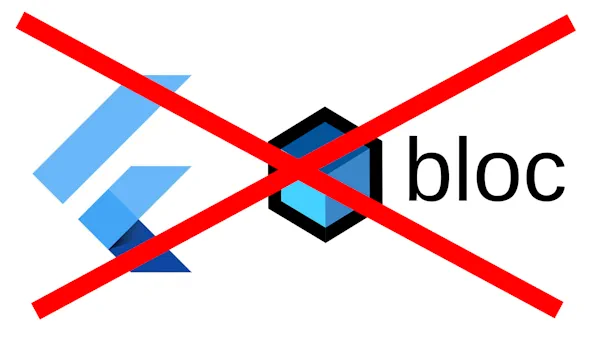When BLoC is too much
Published on

Flutter's BLoC (Business Logic Component) library has earned its reputation for discipline and testability, but it is not a default choice for every code-base. Below are objections that come up again and again when teams decide to move away from BLoC.
Heavy boilerplate slows momentum
A single feature typically spawns three new files: events, states, bloc and the widget glue. Even BLoC
supporters publish "boilerplate-reduction" packages such as warped_bloc whose entire raison-d'être is to hide
repeated code.
Flutter's own MVVM sample contrasts sharply: one ChangeNotifier class and a couple of
notifyListeners() calls.
Steep learning curve for newcomers
Streams, yield*, BlocObserver, transformEvents and
Equatable impose a conceptual tax that new hires must pay
before shipping UI. Medium tutorials routinely list "steeper learning curve" as the first disadvantage of BLoC
compared with Riverpod or MVVM.
Over-engineered for small & medium apps
When the UI and its state are tightly coupled-think toggles, animations, or short-lived wizards-BLoC's separation offers little benefit and a lot of ceremony. Writers who once championed BLoC now warn that it is "overkill for smaller projects with limited state-needs".
File-hopping hurts flow
... and brain. A change to one user flow can mean touching four or five scattered files. Even with IDE navigation, reviewers and refactorers spend non-trivial time rediscovering where a particular state or event lives-a problem Provider or Riverpod sidestep by co-locating logic and view code.
Async race conditions & event queues
Because events are queued and processed sequentially, long-running operations can starve UI feedback or emit stale states. Developers hit “state ping-pong” when two blocs dispatch to each other in a loop; community Q&A threads are filled with workarounds that move logic back into widgets.
Unnecessary rebuilds
Stream emissions bubble through BlocBuilders that may sit high in the widget tree, triggering
renders far below.
Critics note that nested, irrelevant rebuilds can appear unless you sprinkle extra BlocSelectors or
split blocs
more finely.
Verbose cross-bloc communication
BLoC has no built-in composition mechanism. If Feature A needs data from Feature B you either:
- Chain listeners in the widget layer (mixing UI and domain logic).
- Create global singletons that undercut the strict boundary BLoC set out to provide.
Version churn & lock-in
flutter_bloc 8->9 removed default transition logs and changed BlocObserver APIs. Major upgrades
often demand
code-mods across dozens of blocs. Swapping to a lighter solution later means rewriting every event/state pair.
Performance head-room rivals offer natively
Riverpod, GetX and even vanilla InheritedModel give finer-grained listeners without the manual
splitting BLoC
requires, while also bundling dependency-injection or caching that BLoC lacks.
Flutter's modern docs steer elsewhere
Google's own architecture guide (2024) demonstrates MVVM with notifier-based models and explicitly calls out boilerplate as a trade-off rather than a best practice . When the framework authors do not recommend a pattern by default, that is a data-point worth weighing.
Conclusion
Choosing a state management strategy is about optimizing for today's pain, not tomorrow's trend. Flutter's widget tree already gives you a simple, reactive loop. Use BLoC only when the payoff in testability, predictability or team discipline clearly outweighs the undeniable costs in boilerplate, learning time and cognitive load.